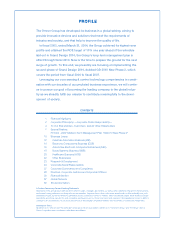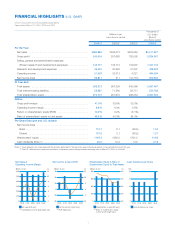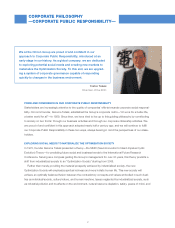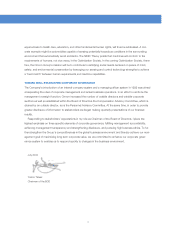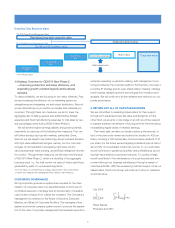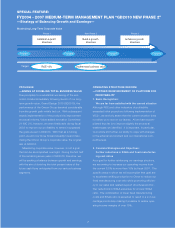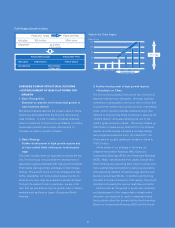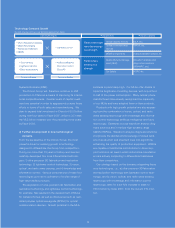Omron 2004 Annual Report Download - page 7
Download and view the complete annual report
Please find page 7 of the 2004 Omron annual report below. You can navigate through the pages in the report by either clicking on the pages listed below, or by using the keyword search tool below to find specific information within the annual report.
5
OUR GROWTH STRATEGY: SOLIDIFYING PAST INITIATIVES
FOR THE FUTURE
1. The Essence and Inevitability of Strategy
Strengthening profitability, growth potential, and
stability to maximize corporate value
It is my conviction that a CEO’s primary responsibility is to respond
to stakeholders’ expectations by maximizing corporate value.
Accordingly, in 2001 the Omron Group formulated Grand Design
2010 (GD2010), a long-term management plan expressing the
desired direction for the Group over the coming decade, with the
priority goal of maximizing corporate value over the long term.
I believe that corporate value is composed of three major ele-
ments. The first of these is profitability. Only by producing profits
that exceed current investment costs can an enterprise begin to
achieve value, and high profitability demonstrates high-added-value
business development based on technology that distinguishes a
company from its competitors. In GD2010, we established 10% of
ROE as a profitability benchmark for our medium-term management
objectives. The second element is growth prospects. Needless to
say, the market places a premium, thus respects the bland value,
only on companies demonstrating growth potential. The third ele-
ment is stability. It is vital that a Company establish a solid earnings
base capable of withstanding volatility in the external environment. In
order to increase profitability and stability, it is necessary to reinforce
both financial and production systems. To raise growth potential,
meanwhile, technology and marketing must be organically integrat-
ed. These principles are the essence of GD2010.
2. Verification of the Past
Strengthening our earnings base
—turning the negative into the positive
Shortly after the launch of GD2010, the Omron Group was hit by a
major downturn in the economy, pushing us off the path of growth
that we had envisioned. In response, from fiscal 2002 we focused
on increasing profitability at an accelerated pace via structural
reforms stipulated in VIC21. Under VIC21, we carried out several
significant reforms. Specifically, an early retirement program led to a
reduction in domestic employment of about 1,460 people.
Furthermore, we closed three plants or partially transferred functions
overseas, and sold or absorbed eight businesses and 11 sub-
sidiaries. At the same time, we achieved cost reductions by under-
taking sweeping re-evaluations of our production processes and
materials procurement. As a result, we achieved all of VIC21’s
numerical targets, including overseas production ratios and busi-
ness portfolio revision as well as reductions in fixed and variable
expenses (¥32.4 billion actual vs. ¥30.0 billion target). This prepared
the ground for the dramatic earnings recovery we enjoyed during
the year under review.
3. Issues for the Future
Offensive-defensive strategic balance for progress in
the next stage of growth
By bringing our profitability targets (ROE) one year forward, I feel
that we are now at a stage where we can work on improving our
growth and stability. This does not mean, however, that our mission
to raise profitability has ended. Despite our gradual strengthening of
our earnings base, it is not yet solid enough to enable us to maintain
superior international competitiveness. Bearing this in mind, we have
divided the remaining seven years of GD2010 into two parts. During
the first four years, from fiscal 2004 to fiscal 2007, dubbed GD2010
New Phase 2, we will implement a strategy of offensive/defensive
balance with an eye to increasing the prospects for growth and sta-
bility, all the while paying keen attention to profitability.
Results of VIC21 Structural Reforms
Period of implementation: April 2002 to September 2003
Reduction in groupwide
fixed and variable expenses . . . . . .
Expansion of overseas
production ratio
(compared with March 2001) . . . . .
Absorption or sale of low-profit
or unprofitable businesses . . . . . . .
ActualTargetItem
¥32.4 billion
52% increase in ratio
8 businesses, 11 subsidiaries
¥30.0 billion
50% increase in ratio
2 businesses, 5 subsidiaries
Review of GD2010 Phase 1
FY00 FY01 FY02 FY03
-5
5
0
10
15
(ROE: %) 10% ROE achieved
1 year ahead of schedule
-10 FY04
6.7
10.0
9.3
8.4
7.5
10.2
0.2
-5.1
Structural Reforms
(VIC21)
Initial ROE target
Actual ROE


